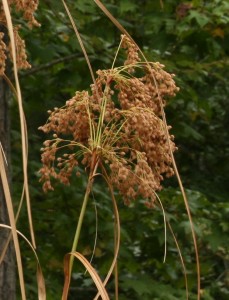Woolgrass – October 2017 Wildflower of the Month
 Not usually a first choice for gardens, Woolgrass (Scirpus cyperinus) grows next to ponds, streambeds, and roadside ditches, where it forms colonies that hold soil and prevent erosion. In naturalized areas this plant looks great with late-blooming fall asters, goldenrods and native shrubs – it’s a nice choice for rain gardens and low moist spots.
Not usually a first choice for gardens, Woolgrass (Scirpus cyperinus) grows next to ponds, streambeds, and roadside ditches, where it forms colonies that hold soil and prevent erosion. In naturalized areas this plant looks great with late-blooming fall asters, goldenrods and native shrubs – it’s a nice choice for rain gardens and low moist spots.
Woolgrass spreads aggressively with creeping rhizomes, which makes it a good candidate for container gardening. This perennial sedge grows to 6 feet tall, usually in large clumps, with long leaves and large flowerheads. They start to bloom in July and by fall the 6-12 inch fruit clusters are red-brown and very fuzzy. The plant is dormant in winter, but the standing foliage provides much winter interest.
This is one of several important species of wetland plants that provide food and cover for waterfowl and other wildlife. The seeds are eaten by waterfowl, and the roots by muskrats and geese. This sedge is native to most counties of Virginia, ranging from eastern Texas to Newfoundland.
Plants in the genus Scirpus are known as bulrushes, and grow naturally throughout North America. All parts of the plant are edible, and have been used for medicines and household items. Flour can be made from the pollen, ground seeds, and dried rhizomes and the young shoots have been eaten as a raw salad or cooked vegetable. The tough stems have been made into baskets, mats, shelters, brooms, and the soft seedheads add comfort to mats and pillows.
By Helen Hamilton, past-president of the John Clayton Chapter, VNPS
Photo: Woolgrass (Scirpus cyperinus) taken by Helen Hamilton in the Williamsburg Botanical
Garden in Freedom Park.
